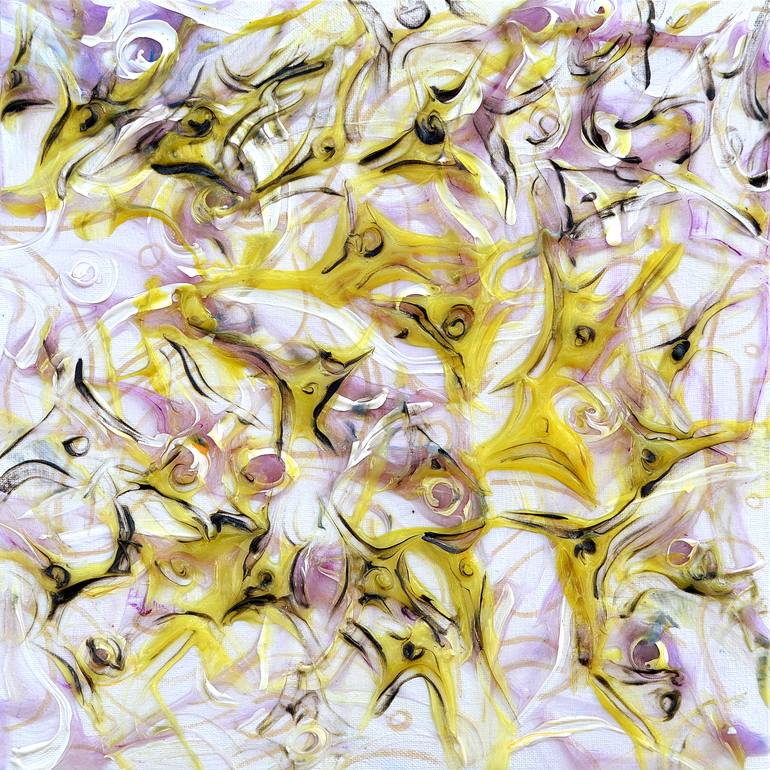


VIEW IN MY ROOM
Neurology Painting
United States
Painting, Acrylic on Other
Size: 12 W x 12 H x 0.2 D in
Ships in a Crate
Artist Recognition

Artist featured in a collection
About The Artwork
Acrylic on panel, 12 x 12 inches Neurology uses layers of transparent tinted and sculpted acrylic gel media to simulate a 3-dimensional micrscopic view of neural tissue. It's somewhere between an abstract painting and a technical schematic. I have a short series of neuron themed drawings and paintings tucked into my science art body of work. The shapes and interconnections of typical neuron morphologies are interesting for abstract paintings, especially as transparent connected layers. Neurology was painted using several layers of sculpted soft gel media. The media was lightly tinted with acrylic paint, just enough for a color without losing the transparency of the dried medium. The shapes of the neurons in each layer were further defined using painted brushstrokes through the edges of the sculpted shapes. The effect is almost like the growth pattern on a tissue engineering sample - brain on a chip instead of lab on a chip.
Details & Dimensions
Painting:Acrylic on Other
Original:One-of-a-kind Artwork
Size:12 W x 12 H x 0.2 D in
Frame:Not Framed
Ready to Hang:Not applicable
Packaging:Ships in a Crate
Shipping & Returns
Delivery Time:Typically 5-7 business days for domestic shipments, 10-14 business days for international shipments.
Handling:Ships in a wooden crate for additional protection of heavy or oversized artworks. Crated works are subject to an $80 care and handling fee. Artists are responsible for packaging and adhering to Saatchi Art’s packaging guidelines.
Ships From:United States.
Have additional questions?
Please visit our help section or contact us.
United States
I am offering a selection of Abstracts and abstracted Science theme work on Saatchi. Please search for me online for my Landscape and Tree of Life bodies of work. I often ask myself whether I'm a physical scientist who also paints, or a painter who has studied a bit too much physics and chemistry. Physics and Chemistry have become a big part of how I model and understand the world. I approach paint texture in terms of it's viscoelastic properties, and color in terms of pigments and their spectra. If you take a cadmium inorganic red and it's organic substitute, gently tweak them so they look almost identical in indirect daylight, will they behave differently in incandescent light? Sunlight? Late afternoon light? (controlled lab light?) Unlike people, fruit, landscapes and other traditional painting subjects, technical ideas and objects don't have an "appearance" in any normal sense of imagery. They're imagined and depicted as visual ideas that guide us through complex phenomena. For example what do like bonds in molecules really look like? Or the quantum not-quite-existence of high vacuum-spawned subatomic particles? The softly dancing dynamic structures in complex fluids? What about "things" that are too small and too delicate for even the best electron microscopes (TEM - SEMs are toys)? I've found that many images scientists create serve as visual similes to data and hypotheses, and as visual metaphors for complex and often highly abstract concepts. These metaphors and their stylized interpretation inspire and guide my "abstract" work.
Artist Recognition

Artist featured by Saatchi Art in a collection
Thousands Of Five-Star Reviews
We deliver world-class customer service to all of our art buyers.
Global Selection
Explore an unparalleled artwork selection by artists from around the world.
Satisfaction Guaranteed
Our 14-day satisfaction guarantee allows you to buy with confidence.
Support An Artist With Every Purchase
We pay our artists more on every sale than other galleries.
Need More Help?